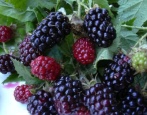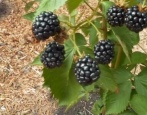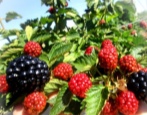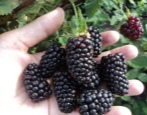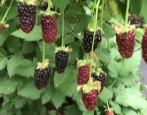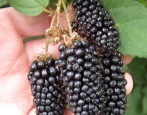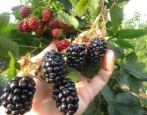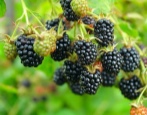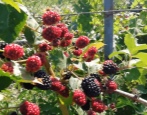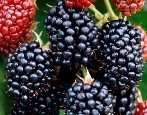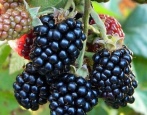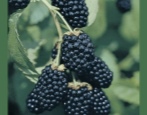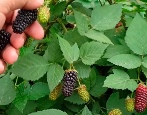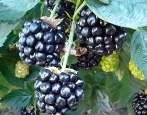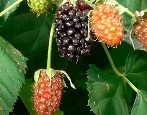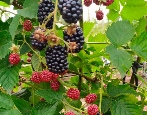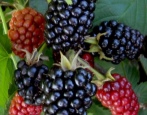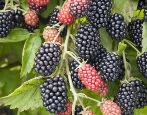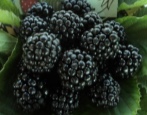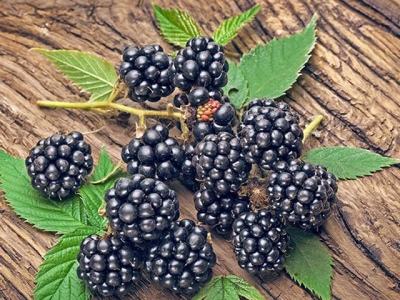
- Authors: USA, University of Arkansas
- Taste: moderately sweet
- Scent : there is
- The presence of thorns: No
- Tasting assessment: 4,9
- Berry weight, g: 4-7
- Berry size: medium
- Berry color: dark blue (in the phase of biological ripeness - deep black)
- Fruiting period: from the beginning of August, lasts about 2-3 weeks
- Yield: 9 kg from 1 m2
Blackberry is a very fragrant and healthy berry that is massively grown in Russia. Especially popular are varieties without thorns on lashes and resistant to temperature extremes. One of these is the Navajo variety.
Breeding history
This variety was obtained thanks to the many years of work of American breeders from the University of Arkansas. They successfully crossed two blackberry varieties Cherokee and Thornfree 30 years ago, resulting in a new studless species called Navajo. The blackberry variety was named after the indigenous people of America.
Today, the Navajo blackberry grows not only on the lands of the USA and Europe, but is also successfully grown on the territory of Russia, Ukraine, Belarus, and breeding and planting have acquired an industrial scale.
Description of the variety
Navajo is a late blackberry variety with a distinct taste, which allows it to be consumed fresh, saturating the body with useful microelements, as well as canning, freezing, cooking compotes and jelly, and baking pies. In addition, the Navajo blackberry is characterized by antipyretic properties.
Ripening terms
The fruiting period of this type of blackberry falls in August-September, that is, the variety is rather late, which means that flowers appear on the bushes in mid-June. This period lasts only 3-4 weeks, but this does not at all affect the yield deficit. After full ripening, the berries do not crumble, which guarantees their integrity. The timing, duration of ripening and fruiting may shift slightly due to the characteristics of the climate, soil, care.
Growing regions
Due to the good tolerance of heat, drought and frost, Navajo blackberries are grown in almost all regions of Russia, with the exception of only a few. During drought, irrigation is used, and in severe frost, the bushes are insulated. The main thing is to follow the elementary rules of caring for the plant, and it will certainly thank you with a bountiful harvest.
Yield
The yield of the variety is high, since the berries are not very large, but there are many of them. Up to 9 kg of berries can be harvested from one m2, but such indicators can be expected after 3-4 years of growth. In the first year, the yield is not very high, but enough to understand how tasty this blackberry variety is.
Berries and their taste
Blackberries are harvested by hand, and sorted into overripe and ripe. Overripe berries are best eaten or processed immediately. The Navajo berry is characterized by medium size, weighing 4-7 grams, conical shape, dark blue color with a glossy finish. A feature of the berries is their miniature grains, which are practically not felt. The taste of the berries is rich, there is sweetness in it without astringency, and it is also worth noting the good juiciness of the fruit and aroma.
Growing features
This blackberry variety with an erect pillar is grown simply, without requiring special skills, adaptations, and besides, it bears fruit stably, which is important if the planting of bushes is of a commercial nature. The shrubs are planted in the spring, from April to May.
Site selection and soil preparation
Despite the unpretentiousness of the variety, the place should be chosen the right one.This should be an area where the sun is moderate, there are no strong winds and high groundwater levels, which create excessive moisture, contributing to rotting of the root system. The optimal environment for the full growth and fruiting of blackberry bushes are loamy and sandy loam soils in regions where the temperature in winter does not drop below -20 ... 25 degrees. The main thing is that the soil is loose, breathable, and also has a neutral or slightly increased acidity level. The site is preliminarily cleared of vegetation residues and completely dug up.
With an optimally selected planting site, as well as with proper care, the bushes will give a stable harvest for 10-15 years.
Pruning
Pruning branches and shoots is required. In the second year of development, a lot of growth appears on the bushes, which should be removed by cutting. At the end of spring, young lashes that have grown more than 1 meter should be shortened by 10-15 cm, which will allow the bushes to grow on the sides. The second pruning is done in the fall, after the end of the fruiting season. The branches on which there were berries must be cut to the base, and the new branches should be slightly shortened.
Watering and feeding
Proper cultivation and care of blackberry bushes requires proper watering and replenishment of the soil with special components. Watering the bushes is carried out at the first time after planting, as well as during the period of active growth, flowering and fruit formation. In small areas with blackberries, you can build a drip irrigation system. After abundant moisture, it is recommended to loosen the soil, and remove the weeds that have appeared.
In early spring, the soil is replenished with ammonium nitrate and urea, and during the ripening period, fertilizers are used for bushes, which contain potassium. Once every 3 years, humus is used at the rate of 3-4 buckets for each blackberry bush.
Frost resistance and preparation for winter
Blackberry bushes are absolutely resistant to drought and severe frosts, down to -20 ... 25 degrees, so seasonal temperature fluctuations will not affect growth and yield. The balance is achieved by wrapping in winter, using spruce branches, vegetable tops, burlap or sawdust, as well as by replenishing the soil with moisture. All the supports on which the bushes are held during growth are dismantled for the winter period.
Diseases and pests
The blackberry variety Navajo is endowed with excellent immunity to diseases and harmful insects, but there are unpleasant situations when the bushes wither, die from the invasion of blackberry or spider mites. Among the diseases that can be infected with bushes, there are septoria and anthracnose. Treatment with insecticidal and fungicidal agents will help to overcome harmful insects and diseases.
Reproduction
Reproduction of this variety is possible in two ways - by planting separate basal offspring and rooting the upper parts of the shoots. These two methods are simple and effective, so even an amateur gardener can handle the seating.
Review overview
Analyzing a huge number of reviews of summer residents and farmers growing Navajo blackberries on large plantations, it can be argued that this variety is unpretentious, quickly takes root, practically does not get sick, is resistant to temperature extremes, and also bears fruit. In addition, farmers note the density of the berries, which contributes to ease of transportation without losing their presentation.
Among the problems that gardeners face when growing this berry, one can single out the construction of drainage for lashes, as well as troublesome insulation for the winter, but this is only for regions with harsh winters.
